Crested Geckos, said to be more officially Correlophus ciliates, have gained significant interest among reptile lovers as they are gentle and take minimum effort to care for. This blog post will explore the concept of Crested Geckos being great pets, emphasizing their ease of maintenance, unique behaviors, and how they are suited to various living conditions. Besides, it shall also give detailed information on how toenail geckos are cared for, including but not limited to their enclosure, temperature, humidity of the habitat, feeding, and medical attention. This article aims to provide information for new or existing gecko owners to create a healthy environment.
What Do crested geckos eat?
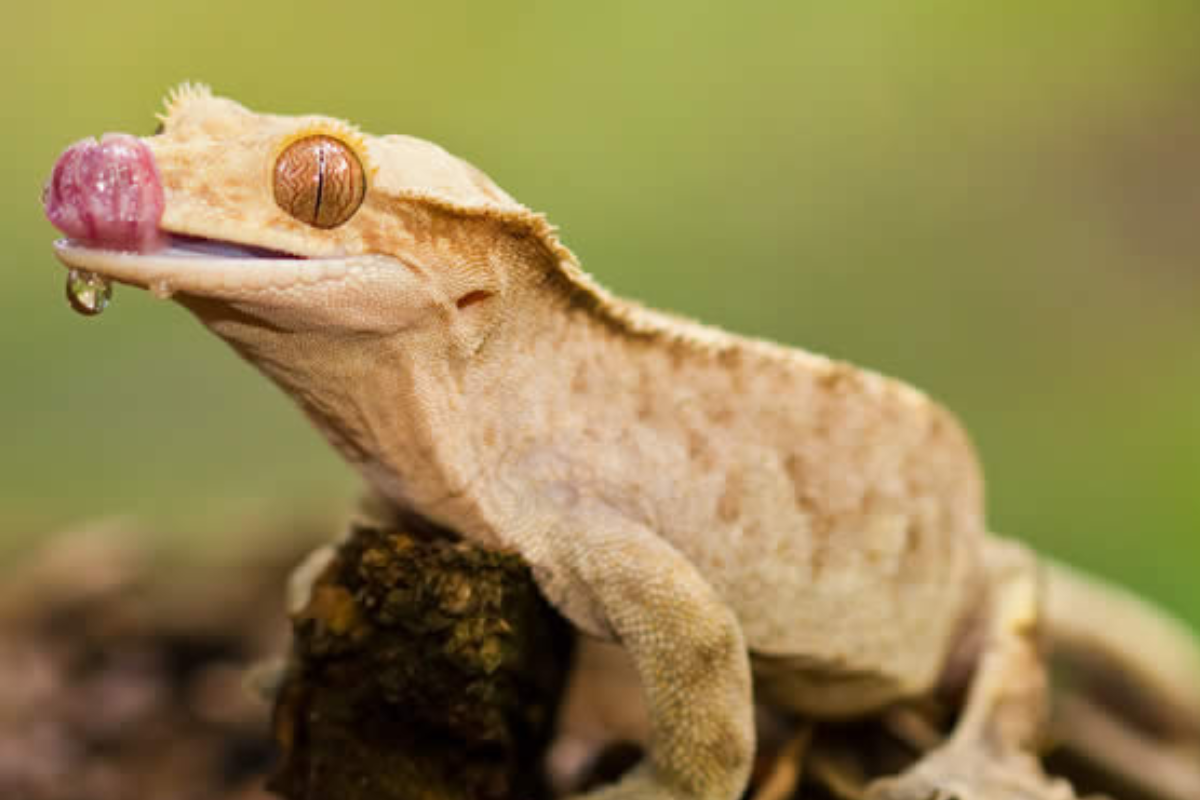
There are Crested Geckos, which are reptile pets that belong to an omnivore diet, and such pets can be fed a combination of commercial gecko food and freshly prepared food. In their natural habitats, these geckos feed on various fruits, nectar, and insects. In comparison with other pets, although a significant number of pet geckos can be fed an MRP gecko diet with high nutritional value, there are some healthy live insects that these pets can be commonly fed with, such as crickets, simply roaches, and this diet edged their hunting instincts. To their remarkable likeness, geckos can also feed on pureed banana and mango fruits. Geckos should be fed meals at the proper intervals while ensuring the food is safe to consume. It is recommended that geckos with an MRP diet are fed calcium and vitamin D3 regularly to prevent metabolic bone disease.
Understanding the Crested Gecko Diet
The active implementation of two strategies – feeding Schedule MRP (Meal Replacement Powder) and providing insects – allows the formulation of an effective diet for Crested Geckos. The basis of such a diet should be feeding MRP-formulated gecko diets and their feeding schedules. Such powders usually meet the dietary needs of the gecko, providing proper proportions of vitamins, minerals, and the right nutrients. The right proportions per dietary calcium and phosphorus ratio are approximately 2:1 and are in appropriate proportions. Bananas or mangos can be offered occasionally but are high in sugar, making them the safest to offer when the base MRP is in the diet.
Using crickets or dubbed roaches with enough proteins and providing physical activity/mind activity is also recommended. All these insects should be progressively gut loaded (tissues or larva) during feeding of the insects. However, it is best to use live food once a week and limit the size of the insect so it does not exceed the space between the eyes of the gecko, as it could potentially choke the animal. It should also be noted that calcium and vitamin D3 deficiencies can be avoided if dust on live prey or mixing calcium with D3 and MRP are used bi-weekly.
A definite feeding schedule while controlling portion sizes and using fresh ingredients is important for caring for a crested gecko. Other important measures to maintaining the optimal health of geckos include regular evaluation of dietary measures taken and modifications depending on the gecko’s growth and health signals.
What Gecko Diet Should You Provide?
When considering the optimal diet for your Crested Gecko, focusing on a nutritionally balanced approach that mirrors their natural feeding habits is essential. The diet primarily consists of a high-quality, commercially formulated gecko meal replacement powder (MRP), efficiently meeting their vitamin, mineral, and nutrient requirements. Brand considerations include Repashy or Pangea products, which often have a favorable calcium-to-phosphorus ratio of approximately 2:1, essential for strong bone development.
Supplement this base diet with fresh, pureed fruits like mango or figs, ensuring these are offered sparingly due to their natural sugar content. Introduce live insects, such as crickets or dubia roaches, once or twice a week to provide the requisite proteins and encourage natural foraging behavior. Ensure these insects are gut-loaded with nutritious foods like carrots or grains for at least 24 hours before feeding.
Calcium supplementation with vitamin D3 should be standardized to at least twice a month, and it can be dusted on live prey or mixed with MRP. This addition is critical in preventing metabolic bone disease. Consistent monitoring of your gecko’s appetite, adherence to portion sizes, and ensuring the freshness of food offerings are imperative practices. Adjustments to the diet should be based on continuous observation of the gecko’s health and behavior, which indicates their overall well-being.
Can crested geckos eat crickets?
Of course, crested geckos can eat crickets. That’s why I incorporate them into their diet — for the added protein and enrichment. It should be noted that to avoid suffocation, the crickets should be no more than the width of the gecko’s eyes. I also ensure the crickets are properly gut-loaded, giving them leafy greens or carrots for 24 hours before feeding. When fed once or twice a week, bugs like crickets encourage their foraging behavior. To supplement healthy bones and prevent metabolic bone disease, I ensure the crickets have had calcium and vitamin D3 supplements two times per month.
How to Ensure Proper crested gecko care?
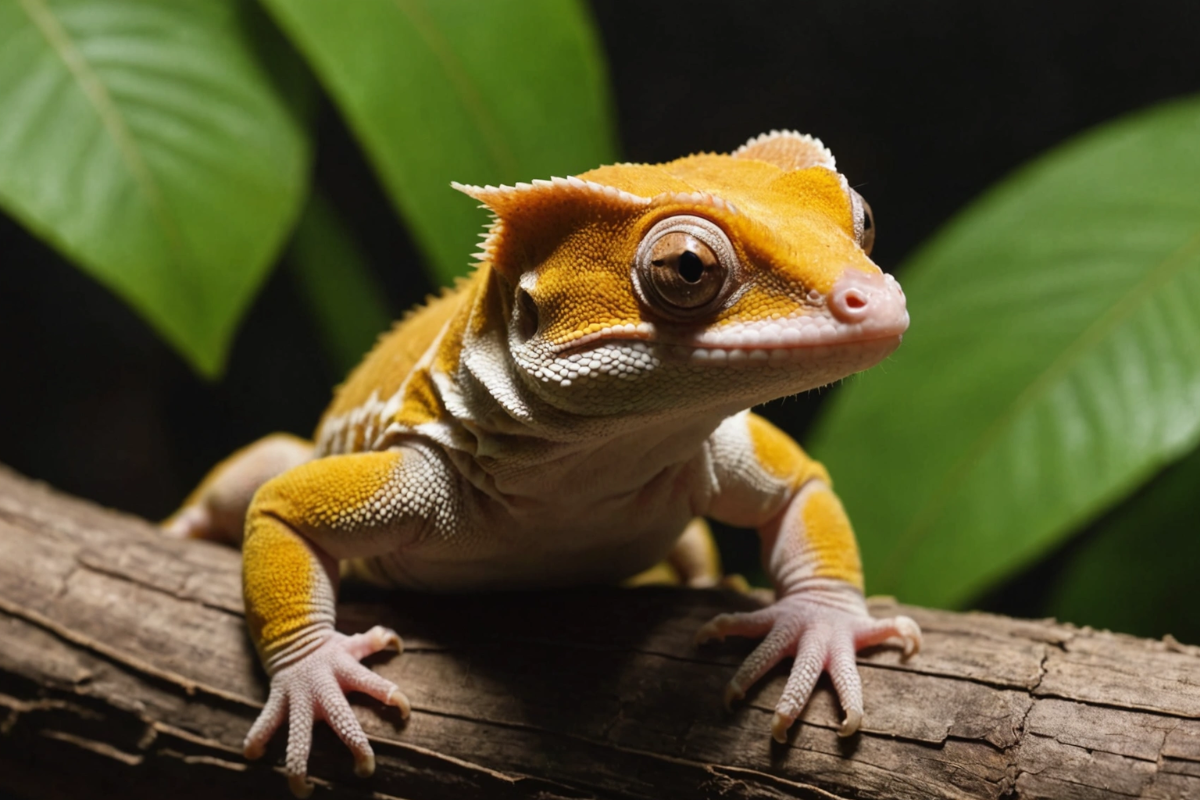
Some key factors also exist in offering appropriate facilities and day-to-day requirements while caring for crested geckos. First and foremost, attempt to start with a large enough enclosure that is well decorated and resembles the gecko’s habitat as closely as possible. A glass terrarium is recommended since they are mainly tree dwellers, providing sufficient vertical length, branches, and leaves for climbing and hiding. Further, 72-78 degrees (22-25 degrees Celsius) should be maintained, although slightly lower temperatures may be observed at night. Humid conditions about 50-70 percent humidity levels must also be maintained.
Understanding the Crested Gecko Diet
A comprehensive approach to their diet involves offering a balanced commercial gecko meal replacement powder alongside occasional live insects like crickets or dubia roaches, which contribute essential protein. Fresh, pureed fruits can supplement meals sparingly, providing additional vitamins.
What Gecko Diet Should You Provide?
Select a commercial gecko diet that is nutritionally complete. It includes adequate vitamins and minerals, specifically calcium and vitamin D3, to prevent deficiencies and metabolic bone disease.
Can Crested Geckos Eat Crickets?
Of course, you can provide crickets to your crested gecko as part of the diet. Apart from capturing crickets, these insects give geckos protein and help them participate in natural hunting activities. Only crickets about the same size as the head of the gecko should be selected to avoid choking hazards or digestive problems.
With the help of these care tips, keeping crested geckos becomes more pleasant and allows them to maintain their health, behavior, and life span. Periodic examination and watchful care will also guarantee that these amazing reptiles will not suffer in an artificial environment.
Maintaining High Humidity Levels
Maintaining appropriate humidity levels is critical for the health and comfort of crested geckos, as inadequate humidity can lead to dehydration and shedding problems. Keep the enclosure’s humidity levels between 50-70%, achievable through regular misting and incorporating water-retentive substrates like coconut fiber or sphagnum moss. It’s advisable to mist the enclosure twice daily, once in the morning and once in the evening, to replicate the natural moisture cycle. Ensure that the enclosure is well-ventilated to prevent mold growth. Utilize a hygrometer to monitor humidity levels and make necessary adjustments accurately. Providing a shallow water dish can also aid in maintaining ambient moisture and offering a supplemental hydration source for the gecko. Consistent observation and incremental adjustments will help maintain an environment conducive to the gecko’s health and well-being.
Choosing the Right Substrate
Selecting the ideal substrate for your crested gecko’s enclosure is essential for maintaining its health and replicating its natural habitat. A well-chosen substrate contributes to both humidity control and your pet’s safety. Popular choices include coconut fiber, sphagnum moss, and coarse orchid bark, which effectively retain moisture and facilitate proper humidity levels between 50-70%. It’s paramount to avoid substrates that pose an impaction risk, such as loose sand or gravel, as they may be inadvertently ingested.
Technical Parameters:
- Humidity Retention: Substrates like coconut fiber and sphagnum moss can maintain humidity within the recommended 50-70% range.
- Safety: Use non-toxic, natural fibers to reduce risks of ingestion and impaction.
- Cleaning: Choose substrates that allow for spot cleaning and periodic replacement to maintain hygiene.
Regular (e.g., weekly) inspection and partial substrate replacement can prevent the build-up of harmful bacteria. By selecting the appropriate substrate, you support optimal humidity and create a safe, comfortable environment for your crested gecko.
How often should you mist the enclosure?
To ensure optimal humidity levels for my crested gecko’s enclosure, I mist it twice a day—once in the morning and once in the evening. This schedule replicates their natural moisture cycle, helping maintain humidity between the essential 50-70% range. Proper ventilation prevents mold growth, so I regularly check the enclosure for adequate airflow. I utilize a hygrometer to monitor humidity levels accurately, allowing me to make necessary adjustments promptly. This routine provides a consistent environment conducive to the gecko’s health and overall well-being.
Technical Parameters:
- Misting Frequency: Twice daily, morning and evening.
- Humidity Range: Maintain between 50-70%.
- Monitoring Equipment: Use a hygrometer for precise humidity measurement.
- Ventilation: Ensure enough airflow to prevent mold.
Do Crested Geckos Make Good Pets?
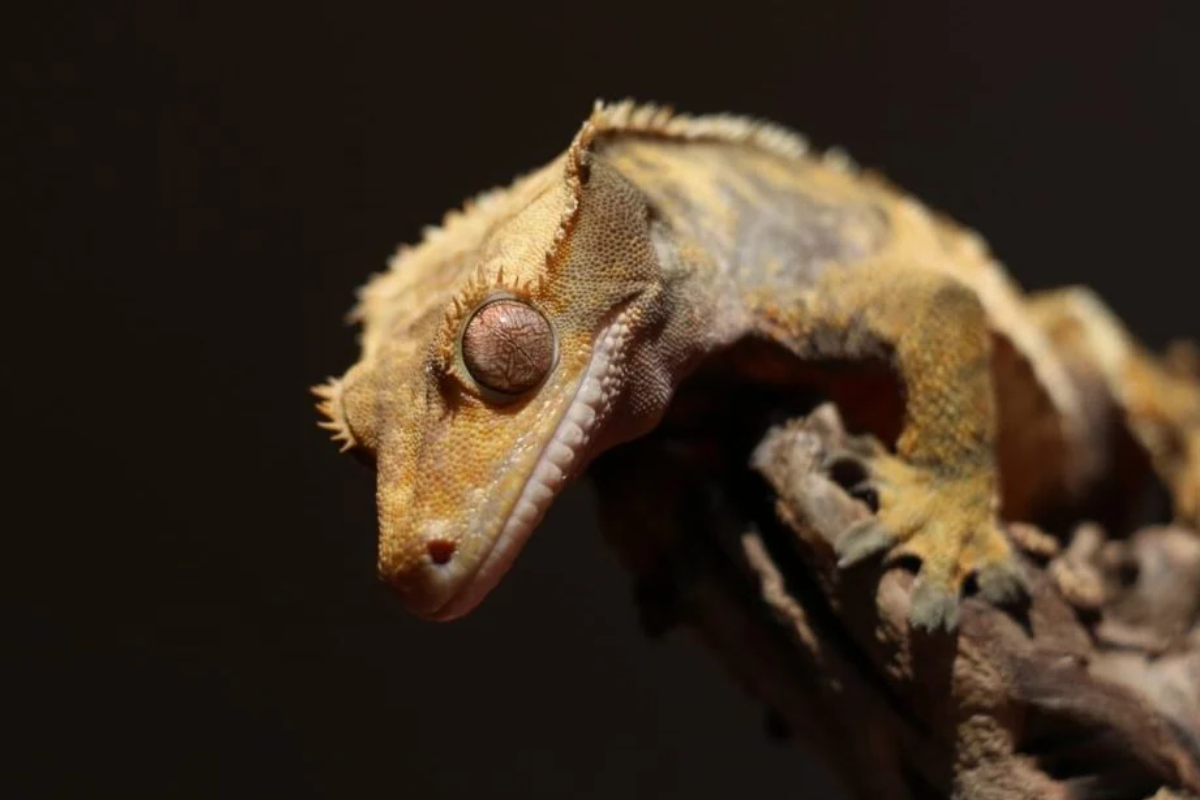
Crested geckos are gaining momentous popularity as pets, which can be attributed to many reasons. First, they are incredibly calm and very gentle, making them ideal even for kids or people with no prior experience with a reptile. They are also relatively easy to care for, mainly due to their specific dietary requirements and care. Of course, these geckos do not require much attention and do not need heating or specialized equipment such as UVB light. Furthermore, a variety of features adds up to their beauty: rough skin with small crest-like structures that sit on top of their eyes and stretch down their back. Other than that, they are not picky in terms of space and can attain a space of appropriate size. Since they are nocturnal, they are also best suited for many different lifestyles. It is hard to argue that crested geckos make perfect pets due to how they are kept, their behavior, and their stunning look.
Why Crested Geckos Are Nocturnal Companions
Crested geckos (Correlophus ciliatus) have developed specific behaviors and physical adaptations that allow them to be active at night. Due to their ecosystem being in the islands of New Caledonia, crested geckos commonly become active at night to avoid predators and moisture. Their phenomenal eyes are well-suited for seeing and hunting insects in the dark. Also, their times of crepuscular activities coincide with when their prey is pulled out.
Such nighttime functions on the part of the owners imply that they can interact with their pet CBGs at night normally after coming back from work or school. Pets housing this adaptation means that the model requires specific care conditions in captivity, where, as in nature, the geckos spend most of the day hiding, the humidity is at the right level, and so forth.
Technical Parameters:
- Activity Schedule: Primarily crepuscular and nocturnal; active during the night.
- Light Requirements: LED or low-watt red bulbs to simulate moonlight, avoiding bright lights that can disrupt their nocturnal instincts.
- Enclosure Setup: Offer adequate hiding spots using branches and foliage to create a secure environment during daylight hours.
- Feeding Schedule: Provide food in the early evening, aligning feeding times with their natural active period.
Crested geckos, with their ease of care and natural adaptability to human routines, make delightful nocturnal companions and fit seamlessly into the lifestyle of modern pet owners.
Benefits of having a reptile pet
For someone who is a reptile owner and fan, there are many advantages to that. To begin with, let us look at reptiles such as the crested gecko. Such pets don’t require much attention and do not need to be walked daily. That alone helps them fit perfectly into my busy schedule. Their needs in terms of space are pretty simple, as only minimal changes would be required to enable normal activities, thus making the setup and maintenance easier. In the same vein, reptiles are also quite renowned for their different types of interaction and are pretty passive, which means that a person does not need to engage much with them at home. From a financial perspective, reptiles are also relatively less costly than pets such as dogs or cats because of their relatively low feeding costs and repairs. Last but not least, crested geckos, or any other reptile, enhance my scope of knowledge about herpetology and conservation, which helps me appreciate these beautiful creatures and their environment even more. Lastly, it can be deduced that reptiles are suited for my living environment and provide me with an exciting yet educational pet.
Are they easy to care for?
Crested geckos are perfect for enthusiasts of any skill level, as their care is pretty straightforward. All they require is gecko pellets,s which are easy to procure and prepare. Their cages do not need complicated DLL or unique heating fixtures, making them more accessible than some reptiles. Regularly mist your geckos and keep the humidity between 50 to 70 percent. Geckos love naturalistic aquaria rich in plants and structures for climbing and security. When done right, there isn’t much of a discrepancy between the conditions in the home and natural habitats, thus making crested geckos ideal for ordinary households as they don’t require much attention to detail.
Technical Parameters:
- Diet: Use commercial gecko food supplemented with occasional live insects.
- Lighting: No special UVB requirement; use ambient room lighting.
- Humidity: Maintain 50-70%, using regular misting.
- Enclosure: Naturalistic setup with branches and foliage for climbing and hiding.
Creating the Ideal Crested Gecko Habitat
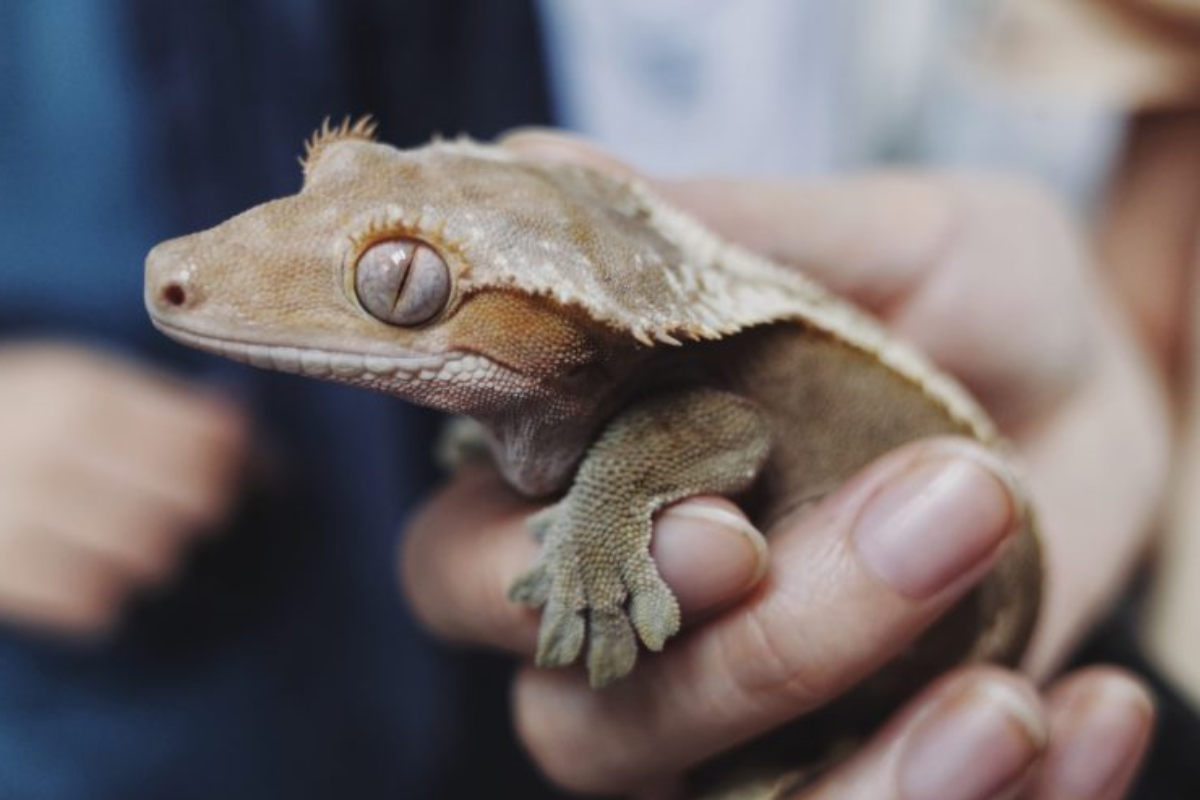
An ideal crested gecko habitat should replicate the tropical environment they naturally inhabit. First, select a glass terrarium that provides sufficient vertical space, ideally 20 gallons for a single adult gecko, to accommodate their arboreal lifestyle. Incorporate various climbing structures, such as branches, vines, and foliage, to encourage natural behaviors like climbing and hiding. Ensure the substrate is suitable for maintaining humidity and is safe if ingested, such as coconut fiber, which also promotes digging and environmental enrichment.
Maintaining High Humidity Levels
Humidity is crucial for crested geckos, with optimal levels ranging from 50-70%. Regularly misting the enclosure, particularly in the evening when they are most active, helps achieve these conditions. Installing a hygrometer will assist in monitoring and maintaining the appropriate humidity levels.
Choosing the Right Substrate
The substrate contributes to humidity retention and affects the gecko’s overall well-being. Coconut fiber or eco earth is recommended due to its absorbency and natural appearance. Avoid loose substrates that might cause impaction if ingested.
How Often Should You Mist the Enclosure?
Aim to mist the enclosure at least once daily to maintain adequate humidity, ideally in the evening to coincide with the gecko’s active period. Monitor the moisture to ensure it doesn’t drop below the threshold, adjusting the misting frequency as needed.
By carefully setting up and maintaining these environmental conditions, owners will provide a thriving habitat that meets the crested gecko’s physiological and behavioral needs.
Setting Up a Terrarium for Your Gecko
Setting up a terrarium for my crested gecko is a strategic process that ensures the enclosure mimics their natural tropical habitat. Here’s how I achieve it:
- Selecting the Right Terrarium: I chose a vertical glass terrarium with a capacity of at least 20 gallons for my adult gecko. This size accommodates their arboreal nature and provides ample vertical space for climbing.
- Incorporating Climbing Structures: To encourage natural behaviors, I filled the terrarium with branches, vines, and plenty of foliage. This setup facilitates climbing and exploration and creates secure hiding spots, which is imperative for their sense of security.
- Substrate Choice: I chose coconut fiber as the substrate due to its ability to retain moisture, which aids in maintaining the necessary humidity levels. It also offers a natural appearance and is safe for ingestion, avoiding the risk of impaction.
- Maintaining Humidity: It is vital to keep the humidity between 50% and 70%, and I achieve this with daily misting, primarily in the evenings to coincide with their activity cycle. I also monitor conditions using a hygrometer to ensure the terrarium remains within the optimal range.
By carefully setting up these key elements, I ensure that my crested gecko’s terrarium is a functional and comfortable space that supports its health and well-being.
Importance of Ventilation and Humidity
Ensuring proper ventilation and humidity in my crested gecko’s habitat is crucial for their health and well-being. Adequate ventilation prevents the buildup of stagnant air and harmful mold, which could compromise their respiratory health. Meanwhile, maintaining the correct humidity levels—between 50% and 70%—promotes proper shedding and hydration, which are integral to their physiological processes.
To achieve this balance, I’ve incorporated cross-ventilation in the terrarium design using screen tops or side panels, which facilitate air exchange without losing too much moisture. I also rely on a hygrometer to accurately measure and adjust the environment.
Technical Parameters:
- Ventilation: Utilize screen tops or side panels for adequate air circulation.
- Humidity: Maintain levels at 50-70% using a hygrometer for precision.
- Misting Frequency: Mist once daily, preferably in the evening, to support humidity and activity cycles.
By adhering to these practices, I provide a stable environment that mimics their natural habitat, ensuring my crested gecko thrives.
Decorating with Vine and Other Accessories
Adding vines and more ornaments to the terrarium is essential in completing the natural look and in providing an active environment for the crested gecko. Various artificial or natural vines should be added to add more incentive to the look of the tank because they also provide additional climbing spaces. Vines can be shaped around the branches and positioned at multiple degrees of angle, allowing for great terrain versatility and making it more intriguing.
Live plants, including pothos and bromeliads, enhance humidity and air quality but require more care and grow lights. Live or even artificial plants also contribute to a more naturalistic setting. However, artificial plants do not require much effort and still offer great hiding places and camouflage for the gecko, which is necessary for stress management.
Other substrates and elements, such as cork bark, ledges, or small crawls, also help improve the environment by providing different retreat areas and texturing that the gecko needs. Great care should be given to all such ornamental objects, and each one must be bolted firmly. All materials designed for reptiles must also be tested and found nontoxic to reptiles.
Technical Parameters:
- Vines and Climbing Structures: Include multiple, securely anchored vines for climbing.
- Plant Options: For decoration, utilize a mix of live (pothos, bromeliads) and artificial plants; ensure that live plants are non-toxic and reptile-safe.
- Additional Accessories: Incorporate cork bark and small shelters for enrichment and security.
By carefully selecting these elements, you will create a thriving environment that fosters your crested gecko’s natural behaviors and health.
How Long Do Geckos Live?
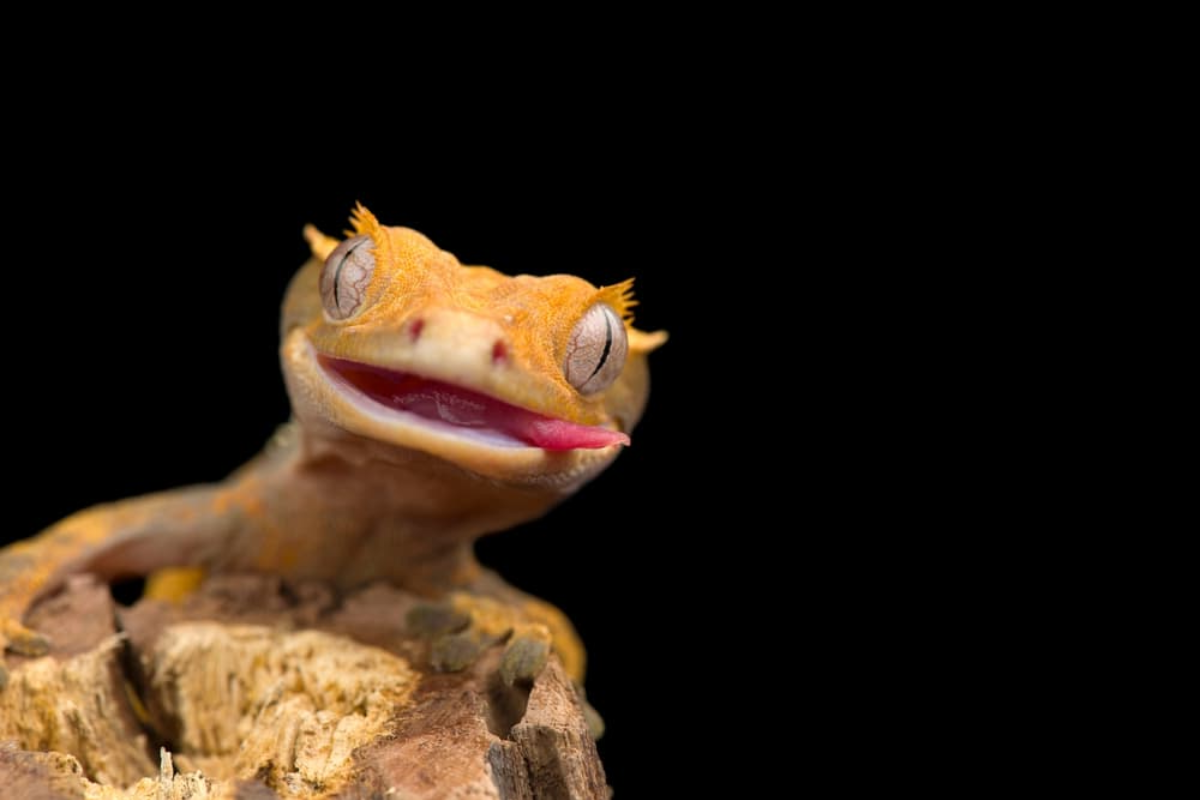
Crested geckos typically live 15 to 20 years in captivity when provided with proper care, though this can vary based on factors such as diet, environment, and overall health care. To maximize their longevity, it is crucial to maintain a controlled habitat closely mimicking their natural surroundings alongside a balanced diet that ensures their nutritional needs are met. Regular health checks and observation can help detect early signs of illness, contributing to your gecko’s long and healthy life.
Average Lifespan of a Crested Gecko
In my experience, crested geckos can live between 15 and 20 years in captivity when they receive the proper care. To ensure my gecko reaches its full potential lifespan, I prioritize maintaining an environment that closely mirrors its natural habitat and providing a well-balanced diet.
Technical Parameters:
- Diet: I offer a varied diet, including commercial crested gecko food supplemented with occasional live insects like crickets or mealworms.
- Habitat Maintenance: Ensure the terrarium replicates its natural environment with appropriate temperature, humidity, and enrichment items.
- Health Monitoring: Conduct regular health checks and watch for signs of stress or illness, adjusting care as necessary.
By adhering to these practices, I aim to support the longevity and well-being of my crested gecko.
Factors that Affect Their Longevity
Dietary habits, environmental conditions, and health maintenance significantly determine the life expectancy of crested geckos. Most importantly, a well-balanced diet should be provided; high-quality commercial gecko food supplemented with appropriate vitamins and occasional crickets or mealworms a few times a week is the best choice. The enclosure has to be an accurate replica of their native ecosystem, and particular care must be taken with temperature and humidity, as both extremes are detrimental to their health and well-being.
Health maintenance is another of the most important in the area. Routine visits and proper monitoring of the gecko’s activity and appearance can assist in recognizing the symptoms of sickness at an early stage. Avoiding stress is also very important, which can be tackled by proper handling and abnormalities in daily regimes. These and related care methods would enable gecko owners to improve the animals’ lifespans considerably.
Technical Parameters:
- Diet: Provide a balanced diet featuring commercial crested gecko food complemented with live insects for protein enrichment.
- Temperature: To avoid thermal stress, maintain a stable terrarium temperature between 72°F and 78°F (22°C and 26°C).
- Humidity: Using reliable measuring tools, keep humidity levels consistent between 50-70%.
- Health Checks: Include routine veterinary visits and regular observation to monitor for changes in health and behavior.
Implementing these practices can ensure that your crested gecko has the best chance of living a long and healthy life.
References
Frequently Asked Questions (FAQ)
Q: Are crested geckos good pets?
A: Crested geckos are considered excellent pets, especially for beginners. They are relatively easy to care for, have docile temperaments, and do not require extensive space. Their unique appearance and “eyelash” crests make them popular among reptile enthusiasts.
Q: What do crested geckos need in their habitat?
A: Crested geckos need a humid environment with plenty of vertical space as they are arboreal and love to climb. Their tank should include branches, vines, and hiding spots. A ceramic heat emitter can maintain appropriate temperatures without drying the air.
Q: How often should I feed my crested gecko?
A: You should feed your crested gecko a diet specifically designed for them, often in powdered form that you mix with water. Juvenile crested geckos may require feeding daily, while adults can be fed every other day. It’s essential to provide fresh food and clean water daily.
Q: How do I handle shedding in crested geckos?
A: When your crested gecko is shedding, it’s crucial to maintain high humidity in its tank. You can mist the enclosure with water to help it shed skin. Ensure that the bottom of its toes and tail do not retain any old skin, as it should grow back properly without obstructions.
Q: What is the best way to clean a crested gecko’s tank?
A: Regular maintenance includes spot cleaning with paper towels and a deep clean every few weeks. Remove all substrate and decorations during deep cleaning, disinfect the tank, and rinse everything thoroughly before reassembling the habitat.
Q: Can crested geckos be handled?
A: Crested geckos can be handled, but it’s essential to do so gently and infrequently to avoid stress. Always wash your hands before and after handling your gecko to prevent the spread of bacteria or irritants.
Q: How do I ensure the health of my crested gecko?
A: Crested geckos require daily attention to ensure their health. Monitor their eating habits, shedding, and behavior. Regularly check environmental conditions such as temperature and humidity in the gecko’s tank to keep them in their optimal range.
Q: What should I consider when buying a crested gecko?
A: When buying a crested gecko, consider its health, age, and temperament. It’s advisable to purchase from a reputable breeder or pet store. Look for a gecko that is alert, has clear eyes, and shows no signs of illness or injury.
Q: Do crested geckos require a heat source?
A: While crested geckos don’t require as much heat as some other reptiles like leopard geckos, a ceramic heat emitter or low-wattage heat bulb can maintain a comfortable environment, especially in cooler climates.
